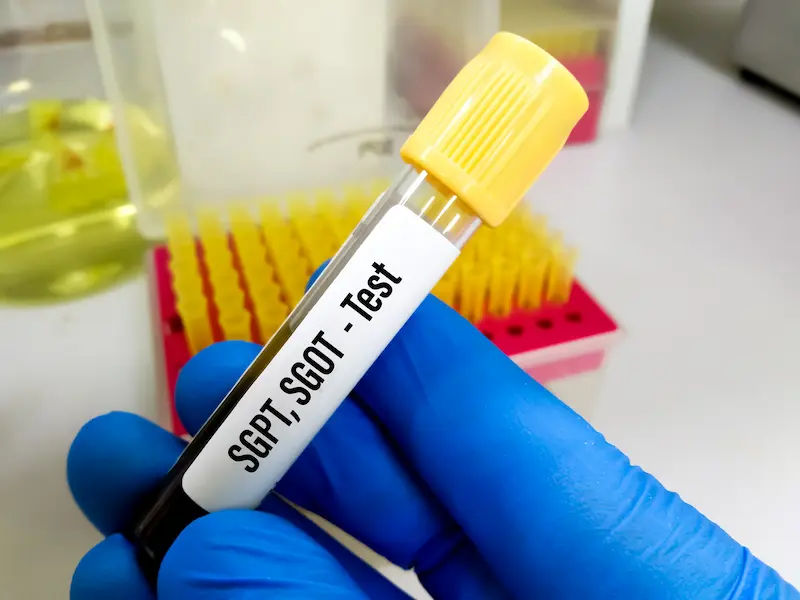Guide to SGOT Test And Normal Range
Learn about the SGOT (AST) test, its purpose, procedure, and normal range. Understand how this liver enzyme test helps detect liver and heart conditions.

.webp?tr=q-80,f-webp,w-350,dpr-2,c-at_max 700w)
Navigating medical tests and their results can be confusing. If your doctor has ordered an SGOT test, you're likely looking for clear, reliable information. The SGOT test, now more commonly known as the AST test, is a simple blood test that offers a crucial window into the health of your liver, heart, and other organs. Understanding what this test measures, what the normal range signifies, and what causes abnormal levels can empower you to have more informed conversations with your healthcare provider. This guide will break down everything you need to know about the SGOT test, from its purpose and procedure to interpreting your results and the next steps to take.
What is an SGOT Test?
The SGOT test is a blood test that measures the level of an enzyme called Serum Glutamic-Oxaloacetic Transaminase. While "SGOT" is a term still widely used by patients and some doctors, the modern clinical term is AST, which stands for Aspartate Aminotransferase. Think of it as the formal name for the same enzyme.
Consult a Top Hepatologist
Why is the SGOT Test Performed?
Doctors don't typically order an SGOT test alone. It's almost always part of a broader liver function test (LFT) panel or a comprehensive metabolic panel (CMP). This provides a more complete picture than a single value.
Symptoms That May Prompt the Test
Your doctor may order this test if you are experiencing symptoms that suggest liver or other organ damage, such as:
- Fatigue and weakness
- Loss of appetite
- Nausea and vomiting
- Abdominal pain and swelling
- Jaundice (yellowing of your skin and eyes)
- Dark-colored urine or pale stools
- Itchy skin
- Unexplained swelling in your legs and ankles
Monitoring Liver Disease
If you have been diagnosed with a liver condition like hepatitis, cirrhosis, or non-alcoholic fatty liver disease (NAFLD), your doctor will use the AST test to:
- Monitor the progression of the disease.
- Check how well the treatment is working.
Understanding the SGOT Normal Range
The "normal" range can vary slightly between different laboratories based on their equipment and methods. Always refer to the reference range provided on your specific lab report.
Typical Reference Values
A typical normal range for AST (SGOT) in the blood is between 8 and 48 units per liter (U/L). It's crucial to remember that a number slightly outside this range may not be immediately alarming; your doctor will interpret it in the context of your overall health and other test results.
Factors That Can Influence Your Levels
Several factors can cause mild, temporary fluctuations in AST levels:
- Strenuous exercise: Can cause minor muscle damage, releasing AST.
- Age and Sex: Normal ranges may differ slightly.
- Certain medications: Including over-the-counter drugs like acetaminophen (Tylenol).
- Pregnancy: Levels can be slightly altered.
The Test Procedure: What to Expect
The SGOT/AST test is a standard blood draw, a quick and common procedure.
Before the Test
Your doctor will inform you if you need to fast (not eat or drink anything except water) for 8-12 hours before the test. This is often required when it's part of a full metabolic panel. Always follow your doctor's specific instructions.
During the Blood Draw
A phlebotomist will clean a site on your arm (usually the inside of the elbow), tie an elastic band to make your veins more visible, and insert a small needle to collect blood into a vial. The sensation is typically a quick prick or sting.
After the Test
You can resume your normal activities immediately. You might have minor bruising or tenderness at the puncture site, which should resolve quickly.
Get Your Health Assessed
Causes of High SGOT Levels
Elevated AST levels indicate cell damage. The degree of elevation can often point toward the cause.
Liver-Related Causes
The liver is a primary source of AST, so high levels often point to liver issues.
- Hepatitis and Viral Infections: Viral hepatitis (A, B, or C) causes liver inflammation and is a common cause of significantly high AST.
- Medications and Toxins: Certain prescription drugs, over-the-counter pain relievers (especially acetaminophen in high doses), and herbal supplements can be toxic to the liver. Alcohol abuse is also a major cause.
- Cirrhosis and NAFLD: Long-term liver damage from conditions like cirrhosis (scarring) and non-alcoholic fatty liver disease (often linked to obesity and diabetes) can lead to chronically elevated AST levels.
Non-Liver-Related Causes
- Because AST is present in other tissues, other conditions can elevate it.
- Heart Attack and Muscle Damage: During a heart attack, heart muscle cells are damaged, releasing AST into the blood. Significant injury to skeletal muscles (rhabdomyolysis) from trauma, extreme exertion, or certain medications can also cause very high levels.
- Other Medical Conditions: Conditions like mononucleosis, pancreatitis, kidney disease, and hemolytic anemia can also lead to elevated AST.
Low SGOT Levels: Is It a Concern?
Low levels of AST are generally not considered a medical concern. They are commonly found in the blood of healthy people and are not associated with any disease states. A low result is typically not a cause for alarm and is often not even commented on by physicians.
Interpreting Your Results: The Big Picture
An isolated AST number is rarely meaningful. The true diagnostic power comes from comparing it to other values, particularly the ALT enzyme.
The AST/ALT Ratio
ALT (Alanine Transaminase) is another liver enzyme, but it is found primarily in the liver. Comparing AST to ALT provides critical clues:
- ALT > AST: This pattern is commonly seen in most types of viral hepatitis and non-alcoholic liver disease.
- AST > ALT: A ratio where AST is significantly higher than ALT (e.g., a 2:1 ratio) is often suggestive of alcohol-related liver disease or cirrhosis.
- Your doctor will synthesize your AST level, your ALT level, their ratio, and the results of other tests (like ALP, bilirubin, and albumin) to form a diagnosis.
What to Do If Your SGOT is High
Don't panic. A high result requires professional medical interpretation.
Discussing Results with Your Doctor
This is the most important step. Your doctor will:
- Review your full medical history, symptoms, and lifestyle.
- Look at the entire panel of blood test results, not just the AST.
- Determine if the elevation is mild and temporary or significant and concerning.
- Order follow-up tests if needed, such as imaging (an ultrasound) or more specific blood tests for hepatitis viruses.
Lifestyle Changes for Liver Health
While you should always follow your doctor's advice, general liver-healthy habits can support your recovery and overall well-being:
- Limit or avoid alcohol.
- Maintain a healthy weight through a balanced diet rich in fruits, vegetables, and whole grains.
- Stay hydrated by drinking plenty of water.
- Exercise regularly.
- Use medications only as directed and inform your doctor of all supplements you take.
Conclusion
The SGOT (AST) test is a valuable tool that provides vital insights into your health, particularly the state of your liver. While seeing an abnormal result on your lab report can be unsettling, it's important to remember that it is a piece of a larger puzzle. It is not a diagnosis in itself. Many factors, from a hard workout to medication, can cause temporary fluctuations. The crucial next step is to consult with your healthcare provider, who can interpret your AST level in the context of your other tests, your health history, and your symptoms. By understanding what the test is and what the normal range means, you are better equipped to be an active, informed participant in your healthcare journey. Prioritize your liver health through mindful lifestyle choices, and never hesitate to seek professional guidance for your medical concerns.
Consult a Top Hepatologist
Consult a Top Hepatologist

Dr. Srinivasa Reddy
Hepatologist
12 Years • MBBS, MD (General Medicine), DM (Hepatology),ASGE
Hyderabad
Myra Liver & Gastro Care, Hyderabad

Dr. Sushith C
General Physician
2 Years • MBBS
Bengaluru
PRESTIGE SHANTHINIKETAN - SOCIETY CLINIC, Bengaluru

Dr. E Prabhakar Sastry
General Physician/ Internal Medicine Specialist
40 Years • MD(Internal Medicine)
Manikonda Jagir
Apollo Clinic, Manikonda, Manikonda Jagir
(150+ Patients)

Dr. Pavan Kumar Y M
Gastroenterology/gi Medicine Specialist
5 Years • MBBS, MD Medicine, DM Gastroenterology
Bengaluru
Apollo Medical Center, Marathahalli, Bengaluru
Consult a Top Hepatologist

Dr. Srinivasa Reddy
Hepatologist
12 Years • MBBS, MD (General Medicine), DM (Hepatology),ASGE
Hyderabad
Myra Liver & Gastro Care, Hyderabad

Dr. Sushith C
General Physician
2 Years • MBBS
Bengaluru
PRESTIGE SHANTHINIKETAN - SOCIETY CLINIC, Bengaluru

Dr. E Prabhakar Sastry
General Physician/ Internal Medicine Specialist
40 Years • MD(Internal Medicine)
Manikonda Jagir
Apollo Clinic, Manikonda, Manikonda Jagir
(150+ Patients)

Dr. Pavan Kumar Y M
Gastroenterology/gi Medicine Specialist
5 Years • MBBS, MD Medicine, DM Gastroenterology
Bengaluru
Apollo Medical Center, Marathahalli, Bengaluru

